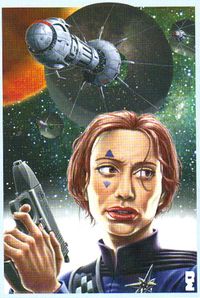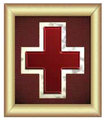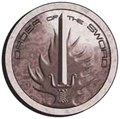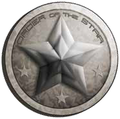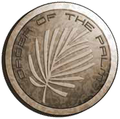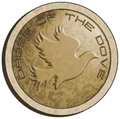Difference between revisions of "Star League Defense Force"
m (replaced description of Martial Olympiad: a short description should still be on this page) |
|||
| Line 223: | Line 223: | ||
====Terran Academies==== | ====Terran Academies==== | ||
| + | The Sandhurst Royal Military Academy in Berkshire, England, was considered one of the three foremost military academies known as the War Triad. This was in part because [[Michael Cameron]], 2<sup>nd</sup> [[Director-General]] of the Hegemony, graduated from Sandhurst. Other notable Terran academies include, but are not limited to, West Point Military Academy, Malinovsky BattleMech and Tank Academy of Russia, Kreig Universitat of Germany, Frunze Military Academy, Annapolis Naval Academy, Kure Naval Academy of Japan, and Saint Cyr Military Academy of France. | ||
====War Academy of Mars==== | ====War Academy of Mars==== | ||
| + | Another member of the War Triad, the War Academy of Mars also functioned as the strategic headquarters of the SLDF. | ||
====Military Academy of Aphros==== | ====Military Academy of Aphros==== | ||
| + | The Military Academy of Aphros was the third member of the War Triad. Its primary responsibility was training fighter and DropShip pilots, as well as one of several institutions overseeing the Gunslinger Program during the [[First Hidden War]]. | ||
====Combat College of New Earth==== | ====Combat College of New Earth==== | ||
| + | The Combat College of New Earth was the first military academy built on an alien world, [[New Earth]]. Constructed in [[2331]], the Combat College maintained a rivalry with Sandhurst Academy until the Amaris Coup. | ||
====Fleet School of Keid==== | ====Fleet School of Keid==== | ||
| + | The third-largest naval academy, behind Annapolis and Kure, the Fleet School of [[Keid]] was responsible for training WarShip and JumpShip crews. | ||
====Flight Academy of Graham==== | ====Flight Academy of Graham==== | ||
| + | One of the few schools that was both orbital and dedicated to training fighter pilots, the Flight Academy of [[Graham IV|Graham]] graduated over 2,000 pilots annually. | ||
====University of Proserpina==== | ====University of Proserpina==== | ||
| + | A very tradition-bound institution, the University of [[Proserpina]] was notable for graduating ten members of [[House Cameron]]. Indeed the basis of the university's unusual and rigid customs were formed by the actions of its Cameron graduates, resulting in officers with a very strong sense of snobbish superiority. | ||
=Second Star League Defense Force= | =Second Star League Defense Force= | ||
Revision as of 13:19, 9 June 2011
The Star League Defense Force (SLDF) was the principal military force defending the Star League, a conglomeration of star systems within roughly 500 light years of Terra. At its height the SLDF was the largest military force known to man, composed of over 100 million soldiers organized into 486 divisions. The Star League Defense Force left the Inner Sphere after fighting the Amaris Civil War, when Stefan Amaris overthrew the ruling First Lord of the Star League, Richard Cameron. In a long series of bloody battles throughout the Star League, Commanding General Aleksandr Kerensky defeated and executed Amaris, however when no new First Lord could be agreed upon the Star League was dissolved. Kerensky then led the surviving 113 divisions out beyond the Inner Sphere in Operation Exodus, hoping to save the essence of the League from the internecine violence that was to come. The SLDF would return 300 years later as the Clans, a technologically superior military that invaded the Inner Sphere in 3049.
Contents
- 1 Organization and Combat Doctrines
- 2 Awards
- 3 Martial Olympiad
- 4 Uniforms
- 5 Ranks
- 6 Commanding Generals
- 7 Military Departments
- 7.1 High Command
- 7.2 Royal Command
- 7.3 Regular Army Command
- 7.4 Naval Command
- 7.5 Special Forces Command
- 7.6 Reserve Command
- 7.7 Replacement-Deployment Command
- 7.8 Judge Advocate General Command
- 7.9 Quartermaster Command
- 7.10 Transport Command
- 7.11 Intelligence Command
- 7.12 Communications Command
- 7.13 Administrative Command
- 7.14 Medical Command
- 7.15 Member-State Liaison Command
- 8 Military Installations
- 9 Military Academies
- 10 Second Star League Defense Force
Organization and Combat Doctrines
At the birth of the Star League, the SLDF was comprised of ~270 regiments of ground forces (conventional armor, infantry and BattleMechs), as well as a fleet of greater than 500 capital vessels. At the outset of the Reunification War the SLDF was divided into 10 Corps. Each Corp was named based on its theater of operations and recruitment:
- First Terran Corps
- Second Rigilian Corps
- Third Altairian Corps
- Fourth Fomalhaut Corps
- Fifth Sirian Corps
- Sixth Astan Corps
- Seventh Procyon Corps
- First Reserve Corps
- Second Reserve Corps
- Star Guard Corps
By the Amaris Civil War the SLDF had over 15,000 regiments and just as many WarShips, JumpShips and DropShips.[1] They were organized into 20 Armies divided between 10 military regions.[2]
- 1st Army (Star League)
- 2nd Army (Star League)
- 3rd Army (Star League)
- 4th Army (Star League)
- 5th Army (Star League)
- 6th Army (Star League)
- 7th Army (Star League)
- 8th Army (Star League)
- 9th Army (Star League)
- 10th Army (Star League)
- 11th Army (Star League)
- 12th Army (Star League)
- 13th Army (Star League)
- 14th Army (Star League)
- 15th Army (Star League)
- 16th Army (Star League)
- 17th Army (Star League)
- 18th Army (Star League)
- 19th Army (Star League)
- 20th Army (Star League)
Composition
Though the composition of each of the Corps/Armies differed, a general rule of organization was maintained though all levels:
- An Army Group consisted of all the Armies assigned to one of the ten military regions. Those assigned to one of the member states were further divided into three districts and bore the name of the state's ruling family, i.e. Army Group Marik.
- An Army consisted of 3-4 Corps. Each of the three districts within each member state's military region was assigned its own Army.
- A Corps consisted of 1-3 BattleMech Divisions, 2-7 Infantry Divisions, several Independent Regiments, as well as its own WarShips and transports. Each Corps was usually assigned 30 worlds to protect, though that number could go as high as 100.
- A Division consisted of 3 Brigades, support units and an ASF Wing, although some had one more or less Brigade. The Division was the heart of the SLDF, usually charged with protecting a group of star systems within one jump radius, or one important system or planet. Divisions were usually classified as one of the following:
- BattleMech Divisions consisted of 2 BattleMech Brigades and 1 Mechanized Infantry Brigade. These units were primarily considered for offensive operations.
- Mechanized Infantry Divisions consisted of 2 Mechanized Infantry Brigades and 1 BattleMech Brigade. It was the most numerous type of unit and could participate in offensive and defensive operations, although the latter was their more usual function
- Infantry Divisions consisted of 2 Grunt infantry Brigades and a 1 light BattleMech Brigade. They were usually assigned to terrain hazardous to mechanized forces, such as cities and mountains.
- Jump Infantry Divisions consisted of 2 Jump Infantry Brigades and 1 BattleMech Brigade, as well as an additional Wing. Jump Infantry were primarily used for quick-strike missions requiring speed and surprise.
- A Brigade consisted of 3 Regiments, and were also sometimes known as Regimental Combat Teams, especially when composed of Light Horse regiments.
- A Regiment consisted of 3 Battalions and was classified as one of the following:
- A BattleMech Regiment was typically organized as a Line Regiment, further classified as either Heavy Assault, Battle, or Striker depending on the role and weight class of their machines. Independent BattleMech Regiments were designed to operate on their own or with an Infantry division against enemies too small to justify sending an entire division. Therefore they also included non-'Mech components such companies of Jump Infantry or fighter squadrons. They were classified as Light Horse, Hussar or Dragoon depending on the role and weight class of their machines.
- Cavalry, Armored, Aerospace and Naval (CAAN) Regiments were Marine Corps units designed to operate on watery worlds, and so included blue water combat vehicles as well as 'Mechs, hovercraft and fighters.
- Armored Regiments were classified as either Heavy, Medium, or Light, as well as Wheeled or Hover. Armored Regiments always consisted of just one type of tank and were usually attached to divisions for anti-'Mech or assigned garrison duties.
- Artillery Regiments had no separate classification, though some included AirMobile Batteries with their own air transport. These regiments were typically attached to divisions, although some artillery battalions would be attached to 'Mech or armored regiments.
- Infantry Regiments were organized as Mechanized, Grunt, Jump or Marine units.
- A Battalion consisted of 3 Companies, also know as Batteries if made up of artillery units. Some BattleMech Battalions consisted of the same type of 'Mech, which helped greatly in reducing repair and maintenance problems.
- A Company consisted of 3 Lances or Platoons if made up of infantry. BattleMech companies were almost always of the same type of 'Mech, though occasionally mixed companies were formed if it members had worked together through one of the Academies but qualified for different designs. The latter were assigned to Independent Regiments.
Combat Role
Ground units of the SLDF were classified and equipped depending upon role.
- Heavy Assault BattleMech regiments consisted of mainly heavy-to-assault weight BattleMechs and a fourth company of artillery. The main assault force of the SLDF, most corps possessed at least a single Heavy Assault regiment.
- Battle BattleMech regiments were the core of most BattleMech brigades, consisting of medium-to-heavy weight 'Mechs.
- Striker BattleMech regiments were reconnaissance and breakthrough formations. Composed of light-to-medium weight 'Mechs, they also included a Recon company of Land Air 'Mechs, and usually had pairs of ASF assigned for their use.
- Dragoon BattleMech regiments were composed of heavy-to-assault weight 'Mechs, tanks and hovercraft, their primary purpose being to fight against well-equipped enemies.
- Hussar BattleMech regiments were the most common of the Independent regiments, composed of medium-to-heavy 'Mechs, tanks and hovercraft.
- Light Horse BattleMech regiments were primarily reconnaissance units, often the first one dropped onto a world to discover the enemy's strengths. Emphasizing light-to-medium weight 'Mechs and vehicles, at least two companies used dedicated information-gathering units like Ostscouts.
- Royal regiments were nearly identical to Regular regiments, with two exceptions. Royal regiments consisted entirely of soldiers of Terran Hegemony birth. Further, Royal regiments are the initial beneficiaries of BattleTechnology innovations - all Royal regiments were equipped with the ultimate in weapons development.
At the core of all SLDF groups were the Royal Divisions, with troops drawn exclusively from the Terran Hegemony.[3]
A list of SLDF commands is available.
Military Regions
General Shandra Noruff-Cameron, the SLDF's first Commanding General, divided the member states into six Military Regions for organizational purposes.[4] The SLDF stationed an Army Group in the Capellan Confederation Military Region, Draconis Combine Military Region, Federated Suns Military Region, Free Worlds League Military Region, Lyran Commonwealth Military Region and Terran Military Region. The Periphery Military Region oversaw the Periphery nations as a whole, but each Periphery nation was assigned its own SLDF Army.[5]
Awards
Martial Olympiad
The Martial Olympiad was a series of mock combats held every four years from 2640 to 2736. The event was designed to test fighting skills and recognize the best units within the SLDF. It took place on the surface and in orbit above Mars, and later Outreach, and involved more than 100 "events" pitting regiments, divisions and space craft against each other. Precautions were made to prevent the loss of life, although deaths did occur, and while it was expensive to maintain the Olympiad was popular among troops as a way to display their skills and the public as a media event.
Uniforms
- Cameronuniformnavaltechnican.png
technican
- Cameronuniformsecurity.png
security
- Cameronuniformmechwarrior.png
mechwarrior
- Cameronuniformnaval.png
naval
- Cameronuniformnaval3.png
naval
- Cameronuniformnaval2.png
naval
- Cameronuniformarmy.png
army
- Cameronuniforminfantry.png
infantry
- Cameronuniformarmor.png
armor
- Cameronuniformaero.png
aerospace
Ranks
| Rank | Insignia |
|---|---|
| Recruit | - |
| Private | |
| Corporal | |
| Sergeant | |
| Master Sergeant | |
| Warrant Officer | |
| Lieutenant | |
| Captain | 
|
| Major | 
|
| Colonel/Commodore | |
| Lieutenant General/Rear Admiral | |
| Major General/Vice Admiral | |
| General/Admiral | |
| Commanding General/Commanding Admiral |
Commanding Generals
| Name | Reign | Rank |
|---|---|---|
| Commanding Generals of the SLDF 2571-2801 | ||
| Shandra Noruff | 2571 - 2575 | General |
| Carlos Dangmar-Lee | 2575 - 2597 | General |
| Nicholas Kinnol | 2597 - 2646 | General |
| Killian Squarn-Turk | 2646 - 2680 | General |
| David Peterson | 2680 - 2707 | Admiral |
| Ikolar Fredasa | 2707 - 2729 | General |
| Rebecca Fetladral | 2729 - 2738 | General |
| Aleksandr Kerensky | 2738 - 2801 | General |
Military Departments
The SLDF was organized into 15 different departments, or commands, each in charge of different aspects of organizing and managing the Star League's military forces. As it was the largest military organization in the history of humanity, each command faced unique challenges unlike their counterparts in the House armies. However, superior training and heavy reliance on computer technology allowed them to fulfill this role with as little as a third of the number of personnel required to run House military departments.[6]
High Command
Royal Command
Regular Army Command
Special Forces Command
Reserve Command
Replacement-Deployment Command
Judge Advocate General Command
Quartermaster Command
Transport Command
Intelligence Command
Communications Command
Administrative Command
Medical Command
Member-State Liaison Command
Military Installations
The SLDF had thousands of military bases and supply depots spread throughout known space; each inhabited world was home to at least one of these installations. Of special importance were those installations built along three defensive rings designed to protect Terra. The first, known as the Home Circle, was built along the border of the Terran Hegemony. The second was built 250 light years from Terran, while the third was built 500 light years from Terran, along the border between the Inner Sphere and the Periphery. Bases along the third ring were the largest and best defended, and more evenly distributed, and most major bases along the defensive rings were home to divisions or major fleets.[7]
Besides the well-known installations, hundreds, potentially thousands, of secret bases were also constructed. SLDF engineers went to great lengths to construct these hidden bases: leveling mountains, draining lakes, building islands in the middle of oceans, and camouflaging their work when construction was complete. Such was their skill that many of these installations have yet to be found, and while most were emptied prior to Operation Exodus some still contain examples of lostech.[8]
Fort
Castle
Castle Brian
Outpost Castle
Port Castle
Mini-Castle
Supply Depot
Military Academies
Of the more than 200 accredited military academies within the Star League, over 100 of them were located on Terra. Of the rest, all but three were located within the Terran Hegemony: Sanglamore Academy, The Nagelring, and Albion Military Academy. The lack of any other foreign academies was due in part to tensions between the Star League and its member states.[9]
Terran Academies
The Sandhurst Royal Military Academy in Berkshire, England, was considered one of the three foremost military academies known as the War Triad. This was in part because Michael Cameron, 2nd Director-General of the Hegemony, graduated from Sandhurst. Other notable Terran academies include, but are not limited to, West Point Military Academy, Malinovsky BattleMech and Tank Academy of Russia, Kreig Universitat of Germany, Frunze Military Academy, Annapolis Naval Academy, Kure Naval Academy of Japan, and Saint Cyr Military Academy of France.
War Academy of Mars
Another member of the War Triad, the War Academy of Mars also functioned as the strategic headquarters of the SLDF.
Military Academy of Aphros
The Military Academy of Aphros was the third member of the War Triad. Its primary responsibility was training fighter and DropShip pilots, as well as one of several institutions overseeing the Gunslinger Program during the First Hidden War.
Combat College of New Earth
The Combat College of New Earth was the first military academy built on an alien world, New Earth. Constructed in 2331, the Combat College maintained a rivalry with Sandhurst Academy until the Amaris Coup.
Fleet School of Keid
The third-largest naval academy, behind Annapolis and Kure, the Fleet School of Keid was responsible for training WarShip and JumpShip crews.
Flight Academy of Graham
One of the few schools that was both orbital and dedicated to training fighter pilots, the Flight Academy of Graham graduated over 2,000 pilots annually.
University of Proserpina
A very tradition-bound institution, the University of Proserpina was notable for graduating ten members of House Cameron. Indeed the basis of the university's unusual and rigid customs were formed by the actions of its Cameron graduates, resulting in officers with a very strong sense of snobbish superiority.
Second Star League Defense Force
In late 3058, the leaders of the Inner Sphere decided to resurrect the Star League in order to defeat the Clans. Victor Steiner-Davion became the first Commanding General of the SLDF since General Aleksandr Kerensky, though the SLDF was composed of only a handful of units. In 3063, Victor resigned as Commanding General in order to avoid a conflict of interest while he led forces loyal to him against his sister, Katherine. Hohiro Kurita succeeded Victor and presided over the disbandment of the SLDF following a vote of no confidence in the Star League in December of 3067.
Units of the Second Star League Defense Force
Though the ultimate goal of the Second Star League was to create a wholly independent SLDF, due to the small number of so called "core" units, the organization relied heavily upon preexisting units from each member-state. Such units were donated for fixed periods of service and operated per the SLDF Chain of Command. [10]
Eridani Light Horse
As a surviving remnant of first SLDF renowned for maintaining the traditions and history of the original, one of their first acts of the Second Star League was to offer the Eridani Light Horse mercenary unit a place in the new SLDF. The ELH accepted, and made its headquarters in Fort Dieron. In addition, the commanding officer of the ELH was promoted from Brevet General to Lieutenant General.[11]
- Command and Transport Division
- 71st Light Horse
- 151st Light Horse
- 21st Striker Regiment
- 19th Cavalry Regiment
Royal Black Watch Regiment
Born of a centuries old secret society within the Northwind Highlanders devoted to maintaining the traditions of the original Black Watch Regiment destroyed in the Amaris Coup, the new Royal Black Watch again serves as the personal bodyguard of the First Lord.[12]
1st Royal BattleMech Regiment
The first entirely new unit commissioned by the Second SLDF, the 1st Royal BattleMech Regiment was formed by Andrew Redburn from the survivors of many of the commands that were destroyed as a part of Task Force Serpent's assault on Huntress. Most of these troops came from the 1st Kathil Uhlans.[13]
Clan Nova Cat
Pledging their allegiance to the reborn Star League, the Abjured Clan Nova Cat was still a force to be reckoned with, contributing both elite troops and the bulk of their WarShip fleet to the defense of the League. While theoretically the entire Nova Cat touman fell under the control of the SLDF, per their agreement with the Draconis Combine a full third had to be retained within the Combine's borders for the defense of the Cat's Irece Prefecture. [10]
References
- ↑ The Star League, p. 105 "Star League Defense Force"
- ↑ The Star League, p. 133 "Unit Composition"
- ↑ The Star League, p. 41
- ↑ The Star League, p. 41
- ↑ The Star League, p. 133 "Army Group"
- ↑ The Star League, p. 129
- ↑ The Star League, p. 132
- ↑ The Star League, p. 132
- ↑ The Star League, p. 108-109
- ↑ 10.0 10.1 Field Manual: ComStar, p. 75-76, "The Star League Defense Force"
- ↑ Field Manual: ComStar, p. 84-89, "Eridani Light Horse"
- ↑ Field Manual: ComStar, p. 97-98, "Royal Black Watch Regiment"
- ↑ Field Manual: ComStar, p. 101, "1st Royal BattleMech Regiment (Morgan's Lion)"



